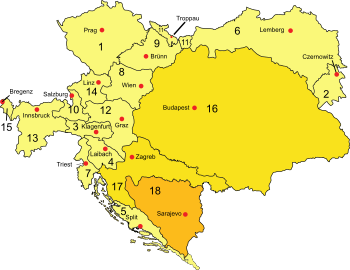Country Manager (Austria-Hungary)
Landeschef 1868-1918 was the officially summarizing term for the governor or the provincial president as a representative of the emperor and central government in the crown lands of the Austrian half of Austria-Hungary .
To the subject
In the law on the establishment of political administrative authorities of May 19, 1868, enacted on the basis of the December constitution of 1867 , the office of the head of the country was defined, which had previously been held at the latest since the Imperial Constitution for the Austrian Empire ( October Constitution ) , Imperial Patent of March 4, 1849, was called governor indefinitely in all parts of the empire .
The head of the country was appointed by the Emperor of Austria to represent himself and the Imperial and Royal Government in Vienna (Section 2 of the Act). In Salzburg , Carinthia , Carniola , Austrian Silesia (Duchy of Upper and Lower Silesia) and Bukowina , the state chiefs carried the title of state president and presided over a state government in accordance with Section 5 of the law , in the other crown lands they carried the title ( k. K. ) Lieutenants and were in charge of a Lieutenancy (so that this title prevailed in public and literature for all crown lands). The function was the same: to lead the administrative apparatus set up by the state as a whole in the Crown Land and to implement the policy of the government in Vienna, by whose instructions the regional leaders were bound.
From 1878 to 1918 the Austro-Hungarian governor of Bosnia-Herzegovina , which did not belong to either of the two parts of the empire, was also designated as head of the country. He was not subordinate to the kk government in Vienna responsible for Cisleithanien, but to the joint finance minister in Vienna responsible for all of Austria-Hungary.
Function of the country chief
The heads of state or governors were appointed and dismissed by the emperor at the suggestion of the Imperial and Royal Government. If it was a crown land with difficult political conditions, the governors were often changed after a short term. Most of the cases were high-ranking civil servants, mostly aristocrats. Some were appointed Imperial and Royal Ministers before or after they became governors.
The head of the state had to present legislative resolutions of the Imperial and Royal Government in Vienna with his opinion in the state parliament; she submitted it to the emperor with her statement for a decision. The emperor could "sanction" the state parliament decision after considering the statements of the head of the state and the kk government (= give his approval to the law decision, according to which the law could be announced and come into force) or reject it (whereby the decision is not made known and not in force could kick). The same procedure had to be followed for planned ordinances that the governor wanted to issue on the basis of laws. He received any instructions from the government in Vienna.
According to the law of 1868, the state chief was responsible for administration, especially in matters of cult and teaching, national defense, public security, agriculture and (due to separate provisions) for finance and trade - matters that were centrally handled by the Reichsrat adopted laws were regulated. Military affairs in the narrower sense lay with their own military authorities. The district authorities, who controlled and coordinated the autonomous communities in their area, were subordinate to the state chief. The authority headed by the head of the state was called the state presidium or lieutenancy.
Each crown land also had an executive appointed by the state parliament, which was responsible for the state competencies. It was led by the executive committee of the state parliament, which was called the state committee (forerunner of the state governments). The chairman of the state parliament and the state committee bore the title of governor (in Lower Austria, Bohemia and Galicia: land marshal ) and was appointed by the emperor as ruler. At that time, the governor was only the No. 2 in the leadership of the crown lands after the head of the state (as had already been introduced after 1742)
Further development of the office in the Republic of Austria
The double structure was eliminated when the First Republic was founded in 1918: With the law of November 14, 1918 regarding the assumption of state power in the federal states, state chiefs (governors, state presidents) and previous state parliaments were established on November 20, the day this law was promulgated abolished and provisional state assemblies and state governments set up with a state governor as chairman. The state governments were bound by the instructions of the German-Austrian State Council . With the Federal Constitution of 1920, the governor was defined on the one hand as the executive body of the federal government in the respective state (indirect federal administration) and on the other hand as the state's top politician in all state competencies. He is elected by the state parliament and sworn in by the federal president.
See also
Individual evidence
- ↑ Law of May 19, 1868, on the establishment of the political administrative authorities in Bohemia, Dalmatia, Galicia and Lodomeria with Auschwitz, Zator and Krakow, Austria under and above the Enns, Salzburg, Styria, Carinthia, Carniola, Bukowina, Moravia, Upper and Lower Silesia, Tyrol and Vorarlberg, Istria, Gorizia and Gradiska and the city of Trieste with its area RGBl. No. 44/1868 (= p. 76)
- ↑ a b RGBl. No. 44/1868 (= p. 77)
- ↑ State law gazettes of all crown lands
- ↑ Law of November 14, 1918 regarding the assumption of state power in the Länder StGBl. No. 24/1918 (= p. 29)
